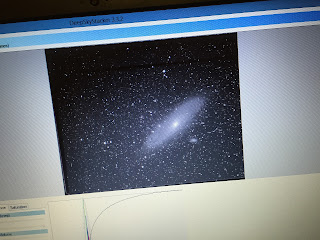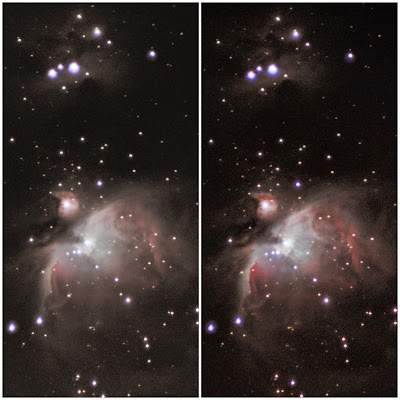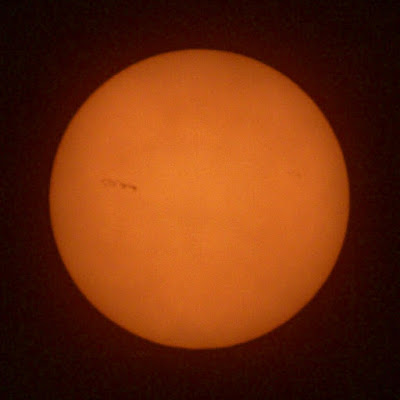The
last time I tried to image the Andromeda Galaxy (M31), I was still just testing out my Orion EQ-1 mount and trying to learn how to align and how it all worked. That time I only took 9 light frames and got my (at the time) best image stacked. Just 9 frames! That shows the benefit of the motor-driven mount for sure. But since then my Canon DSLR astrophotography has gotten a little better.
After I learned the mount a little, I
imaged the Orion Nebula (every beginner's favorite target I'm pretty sure), but didn't go back to Andromeda.... UNTIL NOW! Last night I did a proper treatment of M31 high in the sky directly overhead and with very favorable conditions. Here's how it went down.
 |
| Sometimes you don't realize how far you've come until you look back. |
I aligned slightly to the bottom left of Polaris. Without cross hairs or a finder scope, I'm really just aiming at the center focal point through the viewfinder and hoping for an approximate alignment. I think my best is about 20 seconds, but that night I got 13 seconds without star trails. Not great, but not bad for a simple motor. I bumped it a few times and I'm sure I knocked it out of focus a bit, especially with this lens that seems to jump if you touch it.
Next I had to find Andromeda, but since it was directly overhead, I couldn't do my usual technique of star hopping through the viewfinder. In fact, I couldn't even get my head under the viewfinder. I pulled out the folding screen (this thing has saved my butt a few times) and just started firing off test shots in the general direction. It only took me 16 shots to find the fuzzy blob and then I zeroed in on it.
 |
| Canon T5i on Orion EQ-1 motorized mount (single speed, no tracking) |
 |
| If it looks awkward, that's because it was! I couldn't even see through the viewfinder, I had to just guess and click around for a little while to find my target. |
I wanted to at least give M31 equal treatment compared to my
Orion shot that I love so much, so I let it click away for about 30 minutes doing 160 or so 13 second exposures. Individual frames look like this one (although not all have an airplane buzzing the fuzzy galaxy blob). Quite a close approach considering the field of view is around 5 degrees.
 |
| One of the frames I had to throw out, but kind of a unique image that shows what Andromeda looks like in a single 13 second exposure, and a near miss from an airplane. |
The first thing I did after stacking in DSS (total exposure time 31 min 24 sec) was to crank the curves all the way up just to see what might be hiding in there. I don't use this as a final product, but it is a quick way to see what to shoot for in Photoshop teasing it out bit by bit with curves to avoid the grain of this rough pass. This also proves that I'm not just drawing an oval around the center and turning up the brightness! It really is that bright compared to the surrounding sky. It looks like I just drew a ring around it, but that's really the galaxy itself!
 |
| Cranked the curves all the way up in DSS just to get an idea of what might be hiding in the pixels. It's too grainy to use, but gives me something to shoot for in Photoshop where I have to tease it out bit by bit to avoid the quick-and-dirty grain from the DSS pass at it. |
I'm a little rusty at deep sky stuff. I used curves in Photoshop to tease out the contrast between the dust trails and the brighter parts. I spent about 2 hours on it. My best Andromeda Galaxy (M31) by far! I'm a little rusty on the post processing, but the motor driven mount is night and day compared to a fixed tripod. Really pleased! Might even get a print!
 |
| Canon T5i on Orion EQ-1 mount, stacked in DSS, 159 subs at 13 sec, f/5.6, ISO 1600, 300mm; 27 dark frames, 24 bias, and 15 flat frames (re-used the ones from last year and they seemed to work just fine). |
Take your vitamins and don't skip the flat frames! I'll never go back to not using flat frames on anything that I'm seriously trying to improve on.


















